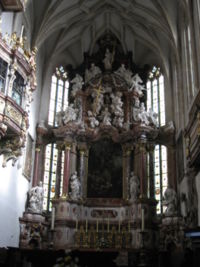
Philipp Jakob Straub
Encyclopedia

Austria
Austria , officially the Republic of Austria , is a landlocked country of roughly 8.4 million people in Central Europe. It is bordered by the Czech Republic and Germany to the north, Slovakia and Hungary to the east, Slovenia and Italy to the south, and Switzerland and Liechtenstein to the...
n sculptor
Sculpture
Sculpture is three-dimensional artwork created by shaping or combining hard materials—typically stone such as marble—or metal, glass, or wood. Softer materials can also be used, such as clay, textiles, plastics, polymers and softer metals...
from a well-known family of German Baroque
Baroque
The Baroque is a period and the style that used exaggerated motion and clear, easily interpreted detail to produce drama, tension, exuberance, and grandeur in sculpture, painting, literature, dance, and music...
sculptors. His father Johann George Straub and his brothers Johann Baptist
Johann Baptist Straub
Johann Baptist Straub was a German Rococo sculptor.-Biography:Straub was born in Wiesensteig, into a family of sculptors. His father Johann George Straub and his brothers Philipp Jakob, Joseph, and Johann Georg Straub were also sculptors, as was his nephew Franz Xaver Messerschmidt. J. B...
, Joseph, and Johann Georg Straub were also sculptors, as was his nephew Franz Xaver Messerschmidt
Franz Xaver Messerschmidt
Franz Xaver Messerschmidt was a German-Austrian sculptor most famous for his "character heads", a collection of busts with faces contorted in extreme facial expressions.-Early years:...
. Although he was born in Germany and studied in Munich
Munich
Munich The city's motto is "" . Before 2006, it was "Weltstadt mit Herz" . Its native name, , is derived from the Old High German Munichen, meaning "by the monks' place". The city's name derives from the monks of the Benedictine order who founded the city; hence the monk depicted on the city's coat...
, he spent most of his career in Austria, first in Vienna
Vienna
Vienna is the capital and largest city of the Republic of Austria and one of the nine states of Austria. Vienna is Austria's primary city, with a population of about 1.723 million , and is by far the largest city in Austria, as well as its cultural, economic, and political centre...
, where he studied at the Academy of Fine Arts
Academy of Fine Arts Vienna
The Academy of Fine Arts Vienna is an institution of higher education in Vienna, Austria.- History :The Academy of Fine Arts Vienna was founded in 1692 as a private academy by the court-painter Peter Strudl, who became the Praefectus Academiae Nostrae. In 1701 he was ennobled as Baron of the Empire...
, and then in Graz
Graz
The more recent population figures do not give the whole picture as only people with principal residence status are counted and people with secondary residence status are not. Most of the people with secondary residence status in Graz are students...
, where in 1730 he joined the workshop of the sculptor Johann Jakob Schoy (1686–1733).
In 1733, upon the death of Schoy, Straub married the widow of his mentor and took over his workshop. He remained in Graz for the rest of his life.
Straub worked primarily in stone and wood in a Rococo
Rococo
Rococo , also referred to as "Late Baroque", is an 18th-century style which developed as Baroque artists gave up their symmetry and became increasingly ornate, florid, and playful...
style that was deeply influenced by local Styrian
Styria (state)
Styria is a state or Bundesland, located in the southeast of Austria. In area it is the second largest of the nine Austrian federated states, covering 16,401 km². It borders Slovenia as well as the other Austrian states of Upper Austria, Lower Austria, Salzburg, Burgenland, and Carinthia. ...
traditions.
His most notable works include the altars (1730) (now destroyed) in the Parish Church of the Holy Blood in Graz
Graz
The more recent population figures do not give the whole picture as only people with principal residence status are counted and people with secondary residence status are not. Most of the people with secondary residence status in Graz are students...
; the statue of St. John Nepomuk
John of Nepomuk
John of Nepomuk is a national saint of the Czech Republic, who was drowned in the Vltava river at the behest of Wenceslaus, King of the Romans and King of Bohemia. Later accounts state that he was the confessor of the queen of Bohemia and refused to divulge the secrets of the confessional...
(1734) in front of the pilgrimage church in Weiz
Weiz
Weiz is a small town of 9,445 inhabitants in the eastern part of Styria, Austria.Its partner city is Grodzisk Mazowiecki, Poland...
; the images of St. John Nepomuk and St. Aloysius
Aloysius Gonzaga
- Early life :Aloysius Gonzaga was born at his family's castle in Castiglione delle Stiviere, between Brescia and Mantova in northern Italy in what was then part of the Papal States. He was a member of the illustrious House of Gonzaga...
(1744–1745) on the altars in the Cathedral of St. Ägydius in Graz; four statues (1764) in front of Schloss Eggenberg in Graz; the high altar and two side altars in the parish church at Ebersdorf (1766); and the figures of St. Michael
Michael (archangel)
Michael , Micha'el or Mîkhā'ēl; , Mikhaḗl; or Míchaël; , Mīkhā'īl) is an archangel in Jewish, Christian, and Islamic teachings. Roman Catholics, Anglicans, and Lutherans refer to him as Saint Michael the Archangel and also simply as Saint Michael...
and two other angels (1769) on the pediment
Pediment
A pediment is a classical architectural element consisting of the triangular section found above the horizontal structure , typically supported by columns. The gable end of the pediment is surrounded by the cornice moulding...
of façade of the Maria-Hilf-Kirche in Graz.

